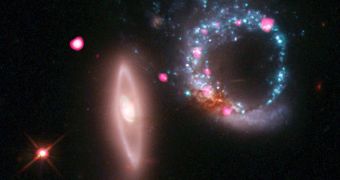In an image released yesterday, February 9, officials at NASA announce the discovery of an impressive string of black holes, which lie in order inside a circular structure millions of light-years away.
Scientists say that the new views of the ring-like structure were taken with a number of space and ground-based telescopes. This allowed them to capture amazing details of the formation.
In addition, the combination of wavelengths also revealed interesting new data about how such a ring is set up. The formation is found around two colliding galaxies, which are jointly called Arp 147.
These objects are in the process of slamming against each other, an event that has been going on for millions of years. During this merger, the two objects join their gas reserves, star systems, and eventually black holes together.
The gravitational and tidal interactions between the spiral and the elliptical galaxy have already spurred high rates of stellar formation. Numerous nurseries now permeate the entire scenery, which is backdropped by remnants of the collision.
Arp 147 can be found in the constellation of Cetus, the Whale, more than 430 million light-years away from our planet. The ring effect it displays originates in the phenomena caused by the intense and rapid formation of new stars.
As the blue stars gather together in this ring, they tend to light it up in bright hues. But these objects do not live for prolonged periods of time, because they are very large and massive.
This means that they are up to tens or hundreds of times the mass of our own Sun. Their lifespan is only a few million years. After that, they either go supernova, or they turn into black holes.
Astronomers looking at Arp 147 through X-ray telescopes say that the ring-like agglomeration of new stars is dotted by black holes, which appear to glow tremendously strong from surrounding signals emitted by regular massive stars.
This allowed researchers to determine that the black holes could be found throughout the cosmic structure. In essence, they mark the death of new stars born when the two galaxies slammed into each other millions of years ago.
For this observation, researchers used readings collected by the Chandra X-ray Observatory, the Hubble Space Telescope, the Spitzer Space Telescope and the Galaxy Evolution Explorer spacecraft, all of which are operated by NASA.
The study concludes by showing that the stellar nurseries in the ring most likely reached “peak productivity” some 15 million years ago, Space reports.

 14 DAY TRIAL //
14 DAY TRIAL //